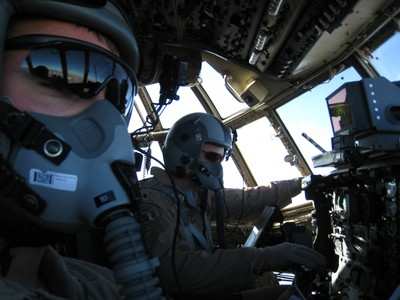Safe, Reliable Delivery For Needed Supplies In Difficult
Terrain
 Villagers
in a remote area of northern Afghanistan recently were the latest
recipients of an Air Force high-altitude airdrop mission that drops
tons of supplies to those in need.
Villagers
in a remote area of northern Afghanistan recently were the latest
recipients of an Air Force high-altitude airdrop mission that drops
tons of supplies to those in need.
The Georgia Air National Guard 774th Expeditionary Airlift
Squadron that flew the Aug. 26 mission deployed from the 158th
Airlift Squadron, Savannah, GA, and delivered eight bundles of
humanitarian aid from a C-130H Hercules. The bundles, weighing
about 4.1 tons, were packaged in a container delivery system, which
assured the bundles and their cargo of food, water, clothes and
blankets arrived intact. Waiting on the ground were coalition
forces who helped distribute the aid to villagers.
The delivery system uses the aircraft's deck angle to move the
containers across roller conveyors on their way out the cargo ramp
and door, said Air Force Tech. Sgt. Ricky Córdova,
loadmaster on the mission, and resident of Charlotte, NC. "When the
bundles are out of the aircraft, parachutes inflate and lower them
to the ground," he explained. "As each bundle clears the cargo
ramp, the rigged high-velocity, low-cost aerial delivery system
parachutes deploy and quickly deliver the load to the people
waiting on the ground." Corrugated paper cushion pads, known as
honeycombs, on the bottom of each bundle help them absorb the shock
when they land, Cordova said.

Air Force Photo
Also aiding in the safe delivery of the humanitarian supplies is
an advanced aircraft computer system aboard the C-130H, operated by
the navigator, said Air Force Lt. Col. Tommy Atkinson, aircraft
commander and a 19-year veteran pilot. "Once the aircraft is over
the drop zone, the co-pilot activates the jump signal switch on
command of the navigator and a green light ignites, signalling the
loadmaster to manually assist the [container delivery system] gate
cut," Atkinson said. The computer program accounts for the
parachutes' drift, the weight of the load, wind velocity and other
variables to ensure the container ends up in the right place, he
said. "These airdrop missions are challenging, and we enjoy that
challenge," the Merritt Island, FL resident said. "What may be lost
on some people is how complicated these missions really are,
because we've been doing them flawlessly for so long."
Air Force Capt. John Mims, navigator on the mission, said even
though the members of the squadron make airdrops look easy, a
tremendous amount of work goes into every detail. "The squadron is
made up of a multitude of career fields, including intelligence
personnel, loadmasters, crew chiefs, navigators and pilots from all
over the United States, all of which are absolutely crucial to the
airdrop missions being completed," Mims said.

Air Force Photo
The squadron has been dropping an average of 5 to 8 tons of
supplies and equipment per mission and will continue to do so as
long as necessary, officials said. Airdrops are a safe and reliable
method for shipping vital supplies into locations where there are
no roads, the terrain is too mountainous, the loads are too heavy
for helicopters or where the insurgent threat is too great.
ANN Salutes Air Force Tech. Sgt. John Jung serving in the 455th
Air Expeditionary Wing public affairs office.
 ANN's Daily Aero-Term (04.25.24): Airport Rotating Beacon
ANN's Daily Aero-Term (04.25.24): Airport Rotating Beacon ANN's Daily Aero-Linx (04.25.24)
ANN's Daily Aero-Linx (04.25.24) Klyde Morris (04.22.24)
Klyde Morris (04.22.24) Airborne 04.24.24: INTEGRAL E, Elixir USA, M700 RVSM
Airborne 04.24.24: INTEGRAL E, Elixir USA, M700 RVSM Airborne 04.22.24: Rotor X Worsens, Airport Fees 4 FNB?, USMC Drone Pilot
Airborne 04.22.24: Rotor X Worsens, Airport Fees 4 FNB?, USMC Drone Pilot





